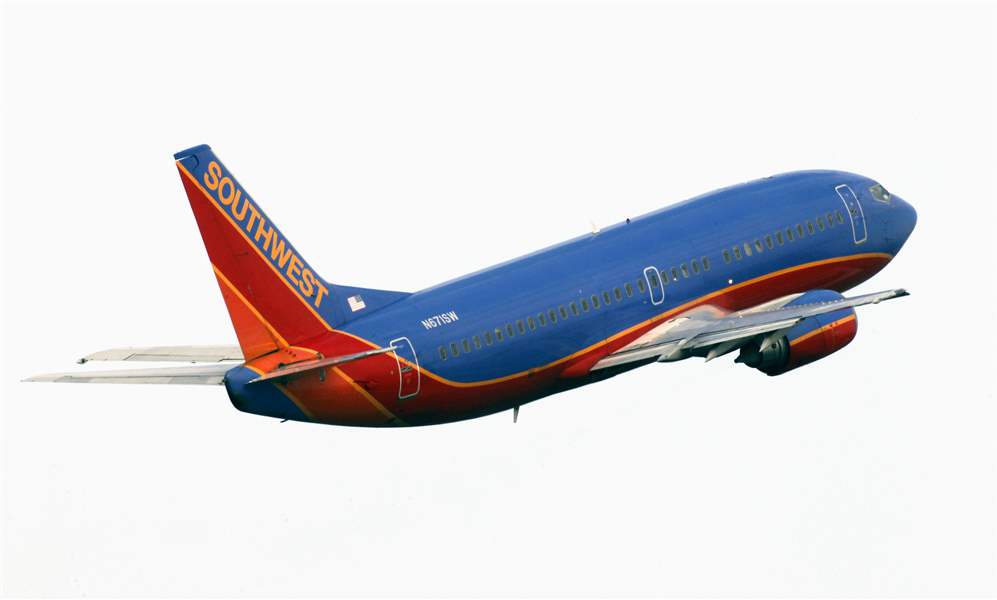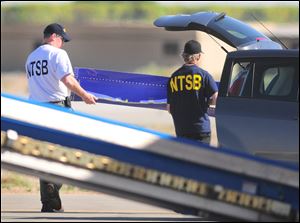
FAA to order more Boeing 737s checked for signs of fuselage cracks
4/5/2011
The FAA says most of the jets in the United States affected by its order are flown by Southwest. The airline said it believes it already has complied with the directive.
associated press

The FAA says most of the jets in the United States affected by its order are flown by Southwest. The airline said it believes it already has complied with the directive.
WASHINGTON -- Federal authorities are requiring airlines to check more Boeing 737 airplanes for metal fatigue after a 5-foot hole opened in a fuselage of a Southwest Airlines jet in midair on Friday.
The Federal Aviation Administration said it will issue an emergency directive today requiring checks of older Boeing 737-300, 737-400, and 737-500 models that have more than 30,000 flight cycles.
The directive will initially apply to about 175 aircraft worldwide, including 80 in the United States.
The agency said most of the aircraft in the United States are operated by Southwest Airlines.
"This action is designed to detect cracking in a specific part of the aircraft that cannot be spotted with visual inspection," FAA Administrator Randy Babbitt said.
Southwest said it believes it had complied with the directive when it grounded 79 aircraft over the weekend for inspections following the emergency landing of Southwest Flight 812 in Yuma, Ariz.
Friday's incident raised questions about the impact frequent takeoffs and landings by short-haul carriers such as Southwest put on their aluminum-skinned aircraft and the adequacy of the inspections. Cracks can develop from the constant cycle of pressurizing the cabin for flight, then releasing the pressure upon landing.
Since there had been no previous accidents or major incidents involving metal fatigue in the middle part of the fuselage, Boeing maintenance procedures called for a visual inspection.
But airlines, manufacturers, and regulators have known since at least 1988 that planes can suffer microscopic fractures. That year, an 18-foot section of the upper cabin of an Aloha Airlines 737-200 peeled away in flight, sucking out a flight attendant.
The order is "certainly a step in the right direction," said Robert Sumwalt, a National Transportation Safety Board member in Yuma, Ariz., with the board's accident team.
As of Monday, Southwest said it found cracks on three other aircraft after inspections of its older Boeing 737-300s.
Southwest returned 64 inspected aircraft into service by yesterday, spokesman Ashley Dillon said. The carrier had canceled about 70 flights Monday out of 3,400 daily flights. "We are hoping to have all of the inspections completed by Tuesday," she said, with the carrier able to run a full schedule at that time.
Three aircraft remain out of service as the carrier said "small, subsurface cracks," were found in them. The three will be evaluated and potential repairs will be made before they can be returned to service.
The carrier said it was using a "nondestructive test in the form of Low-Frequency Eddy current of the aircraft skin," to detect any metal fatigue or cracks in the skin that are not visible to the eye.
According to its annual report filed in February, Southwest said it has 548 aircraft in its fleet, with more than half the fleet Boeing 737-700s with an average age of 7 years. The carrier also has 171 Boeing 737-300s with an average age of 19 years and 25 Boeing 737-500s with an average age of 20 years.
Aging aircraft and issues with metal fatigue rose to national attention in 1988 when the Aloha Airlines Boeing lost part of its fuselage and the attendant was killed. Since then, aircraft manufacturers and the FAA have issued airworthiness directives aimed at checking for fuselage cracks, said John Eakin, who owns Air Data Research in Helotes, near San Antonio.

National Transportation Safety Board members carry a portion of the fuselage from the Southwest Airlines plane involved in the weekend incident to a waiting car as part of their investigation.
"It goes far beyond just the 300 or just the 737," Mr. Eakin said about metal fatigue. "This is an issue that everyone is looking at on all makes and models."
Last year, American Airlines performed additional inspections on 87 of its Boeing 757 aircraft after a 1-foot-by-2-foot hole in an American Boeing 757-200 aircraft opened just above the passenger loading door near the front of the aircraft while the plane was at 31,000 feet.
And in 2009, a hole opened midflight on a Southwest Boeing 737-300. investigators concluded metal fatigue contributed.
Because Southwest uses its aircraft to fly shorter routes, some analysts have speculated the carrier's planes endure more stress, making occurrence of metal fatigue more likely. However, aviation consultant Michael Boyd said Southwest has one of the youngest fleets, with the average age of its planes around 11 years old. The aircraft fleets at Delta Air Lines, United Airlines, and American Airlines have an average age of 15 years.
And because airworthiness directives require maintenance and inspections based on the number of landing and take-off cycles, Southwest may perform maintenance and inspections more frequently, he said. "If you land the plane five times in a day or 5 times in a month, it is the same wear and tear on the airplane," Mr. Boyd said.
The Southwest aircraft involved in Friday's incident was about 15 years old and had around 40,000 cycles.
Bill Voss, president of the Flight Safety Foundation in Alexandria, Va., said the FAA safety order is an acknowledgement that previous inspection procedures were inadequate.
"There is no question this was a very serious safety event," Mr. Voss said.